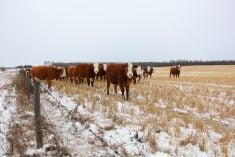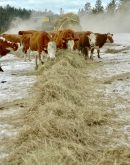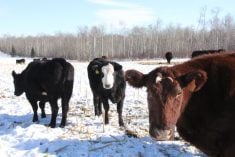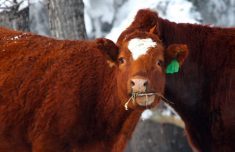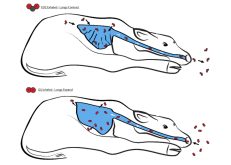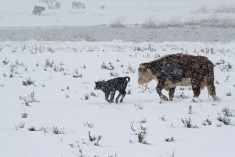Grant and Laura Smith own and operate Brush Hills Ranch near Bentley, Alta. The couple ran an oil and gas service company for 14 years, but recently sold their share of the business and expanded their cow-calf operation from 25 to 180 head, while also adding a small heifer development program.
“We have a real mix in our herd as we’ve been buying out of dispersals,” says Grant. “We weren’t able to pick up a full herd from someone retiring, so we’ve gradually built a mix of primarily Angus-based cows. Our program is only a year old, so I cut myself some slack on this.”
Read Also

Body condition, nutrition and vaccination for brood cows
One of the remarkable events of the past century related to ranching has been the genetic evolution of brood cows….
Confronting challenges
“If you’re starting out cash-strapped and look over the fence at your neighbour and expect to do it how they do it, you’ll never keep up, especially in the cow-calf industry right now,” says Grant.
They had heard the familiar line of how tough it is to get into farming and realized its truth — if they assumed they would be able to springboard ahead 25 years.
“You might as well say it’s tough to get into owning a factory, having a fleet of trucks, or starting a chain of restaurants. With no net worth, that’s where you start and you go from there,” Grant says.
Accessing assistance
Searching for business and economic assistance, the Smiths attended the Ranching for Profit school in Texas. The economics-based training was well-known for assisting owners in treating their enterprises as business ventures and not just a lifestyle.
After completing the Ranching for Profit training, the Smiths joined the Canadian chapter of the school’s Executive Link program, a group of Canadian ranchers who meet regularly to support and hold one another accountable for their financial and economic strategies and goals.
Even though the pandemic slowed the regularity of meetings, Laura Smith explained how the Executive Link platform opened their eyes to new possibilities.
“The culture, the people and everyone’s thoughts around economics and ranching and how to make it a viable business was incredible,” she says. “Ranching has changed over the last 20 years and many strategies used previously aren’t possible now. We wanted to be proactive, but first needed to analyze our ideas and plans.”
Ranching for Profit helped them with this examination as they covered everything from how to handle personalities, deal with family issues, organize grazing and face droughts.
“(Ranching for Profit) doesn’t provide a prescription, but they offer a framework, ask you to examine what you’re consistently doing and help you understand if it makes the most sense. They challenge paradigms and ask, ‘Is this still the best way we can do this?’” Grant says. “They forced us to break down the hard questions of ‘Why do we want to ranch and if we achieved our goals, what would they look like?’”
Changing course
Back home in central Alberta, they considered their place in the community. When purchasing cows, Grant focused on the trends and widened his market search. He sat in on more sales and bought underfed and thin females that were more of a gamble.
“I haven’t been able to figure out the value difference between an $1,800 and a $2,500 bred heifer. How is one going to create more value than the other? Sure, one’s better-looking, but are you going to be able to get the value back on her? I don’t think so.”
They focused on making small tweaks and changes in their operation. First, they realized cow depreciation and salvage values were a huge expenditure each year and this became a larger emphasis in their decision-making process. They lowered stocking numbers below capacity and accepted grazing deeper into the fall. Where they had contiguous land, after pulling bulls, they grouped and ran cattle together. Wherever they had control of owned and rented property, they split it into small paddocks and practiced intensive rotational grazing.
Constant conservation
Conservation of the land, wildlife and birds had always been a passion for the Smiths. While running their service company, they had completed water projects including overflowing dugouts, changing water flows to support wetlands, and erecting swallow and bat houses for insect control. With more expendable income, it had been simpler.
“It’s still a passion,” Grant says. “But now that we’re in a startup phase without off-farm income, it’s harder. I think conservation comes from profitability. You don’t care as much about ducks when you don’t have money.”
Laura says they still build bat and bird houses and have discovered fewer flies are pestering their cattle because of them.
“It’s remarkable, the change from the areas with the houses versus without,” she says. “When you ride out to check cows, you see the proof as the birds swoop down around the cattle.”
The Smiths are comfortable with the growth of Brush Hills Ranch but are cautious as they envision extensive pressure from commodity price increases and volatility in the beef sector. They credit Ranching for Profit for their security level.
“I can’t say enough good things about (Ranching for Profit) and have no clue where we’d be without them,” Grant says. “It’s a tumultuous time right now, but we’re learning as we go. We’ve understood we shouldn’t get caught up in pre-set paradigms and try to concentrate on running the ranch as a business. People talk about lifestyle and that’s fine, but don’t think for a minute the market will forgive you for not providing what it wants.”



